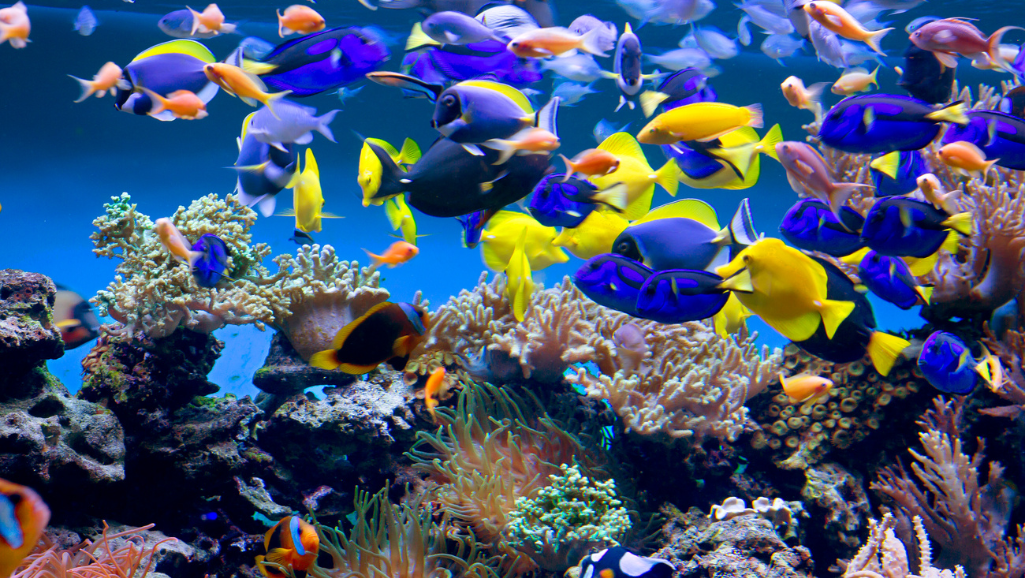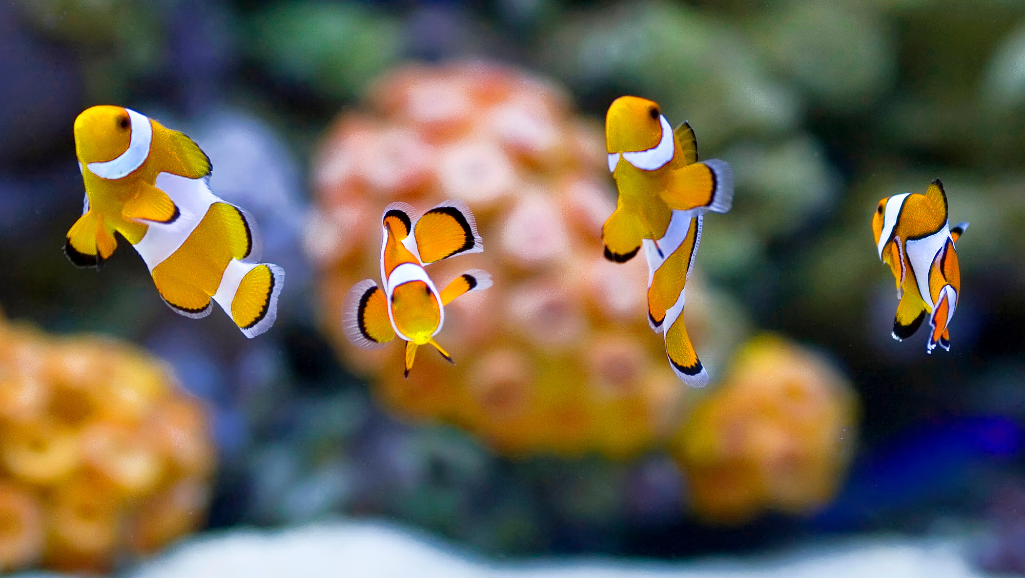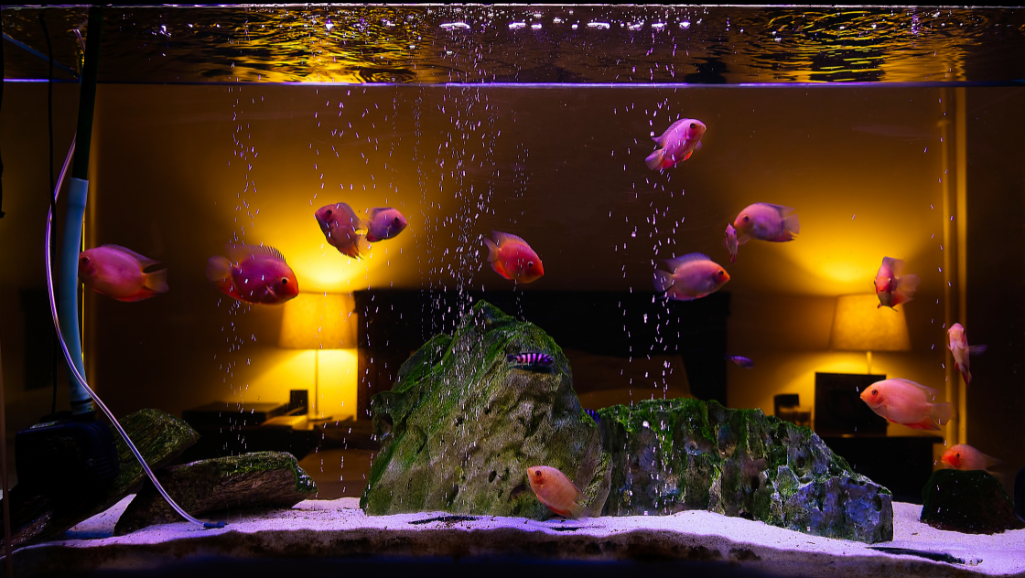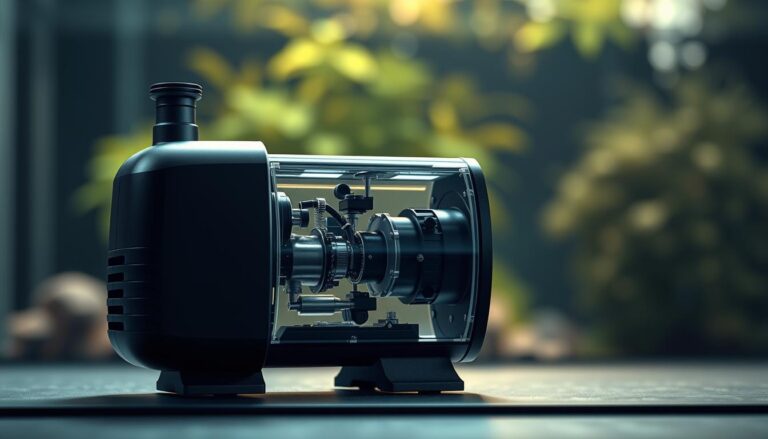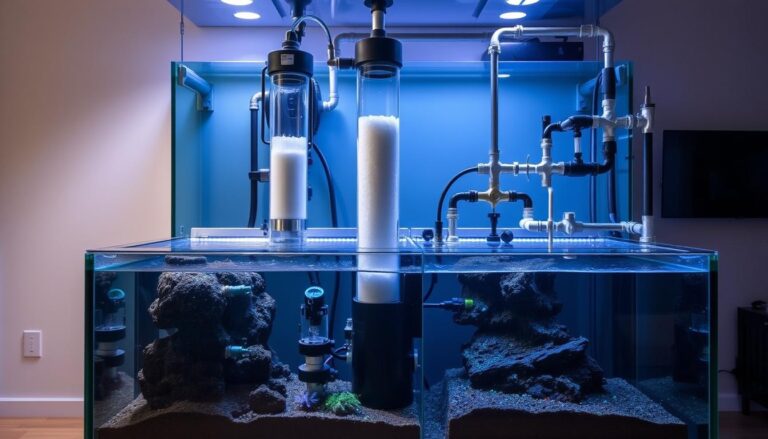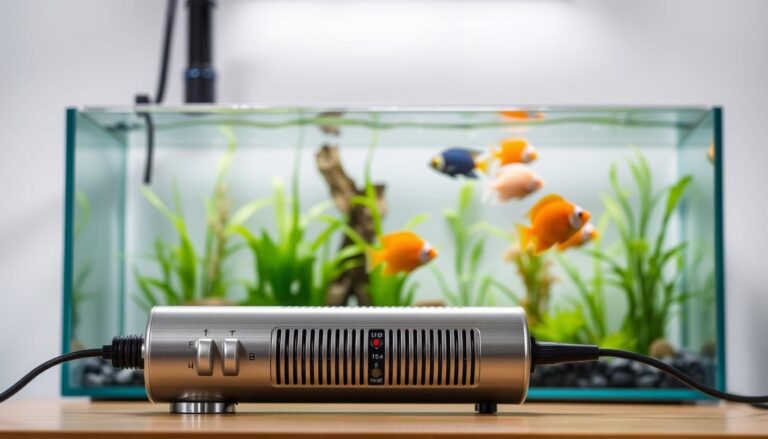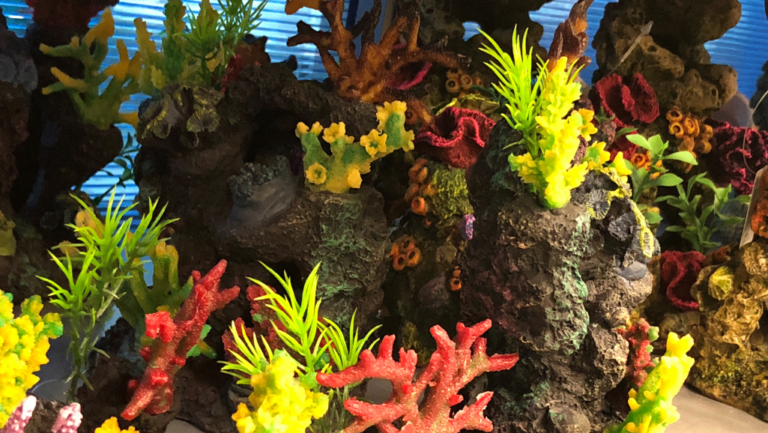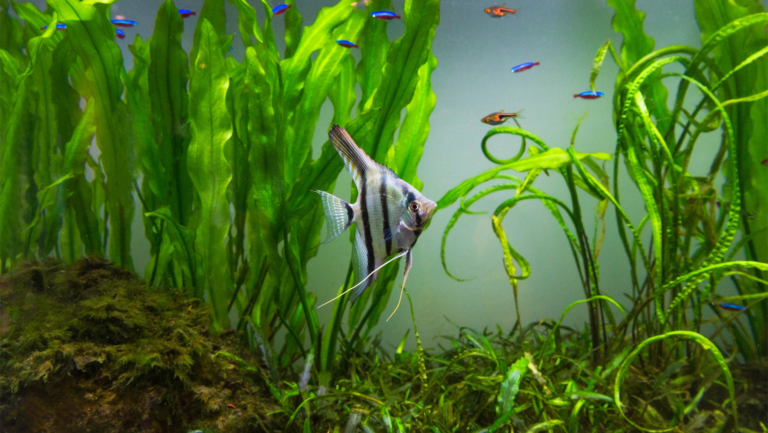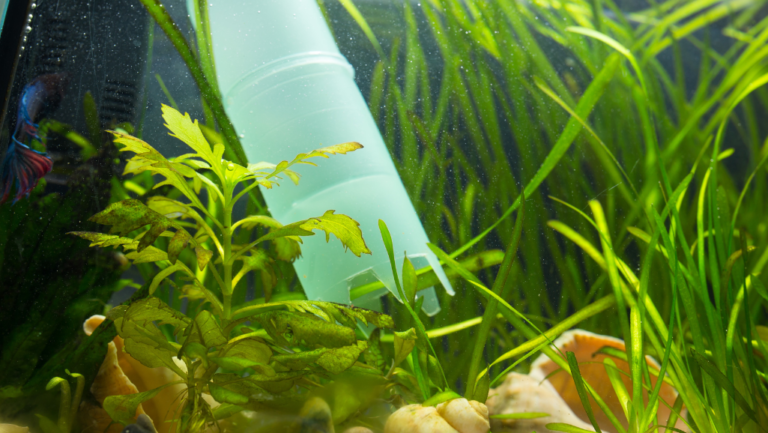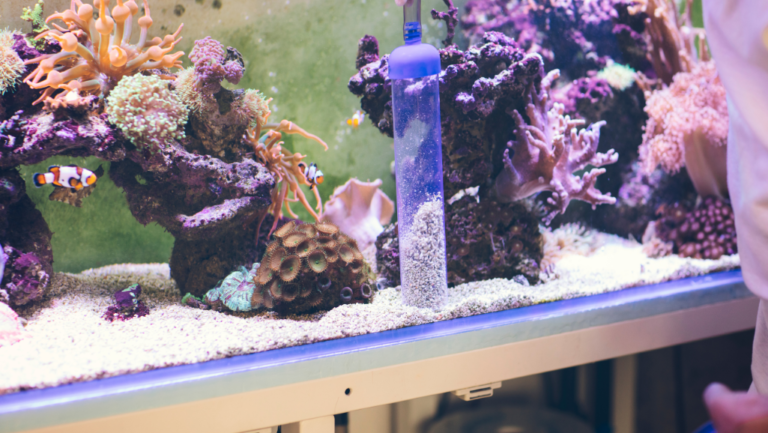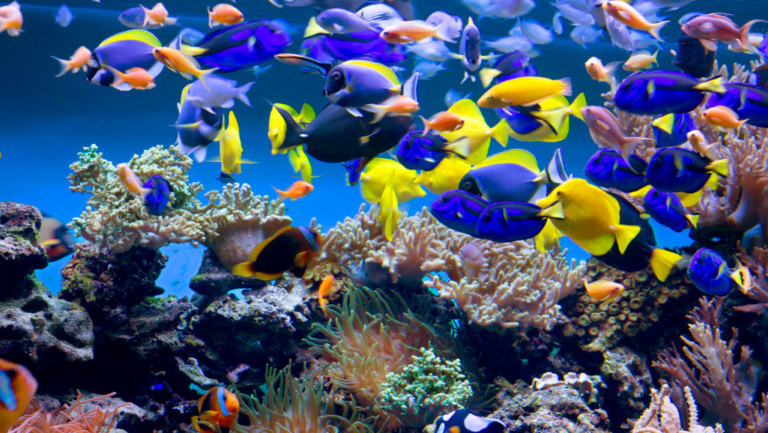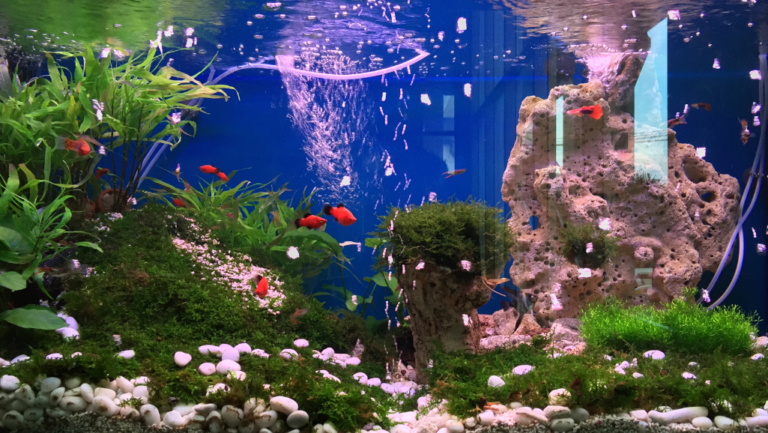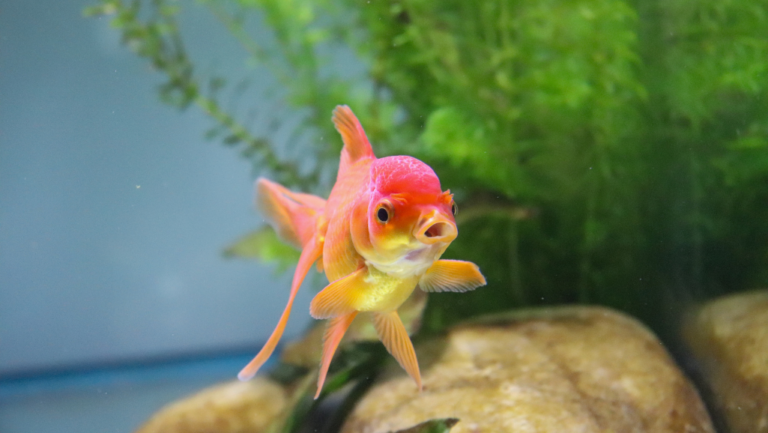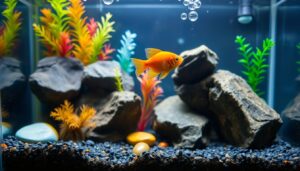Cloudy aquarium water is a common problem for fishkeepers, often seen in new tanks. It may not harm your fish but spoils the tank’s beauty. Luckily, you can make your tank clear and healthy again with the right steps.
Cloudy water in new tanks usually comes from bacterial blooms. These blooms happen when beneficial bacteria grow fast, eating minerals and making the water cloudy. This is normal and should clear up in a week or two if you don’t disturb it.
To speed up clearing, add beneficial bacteria from another tank. Live plants also help by competing for nutrients, starving the cloudy bacteria. Products like Interpet Fast Filter Start and Dr. Tim’s One & Only can help grow good bacteria, fighting cloudy water.
Cloudy water can also come from dirty gravel, appearing right after filling. In older tanks, it might show up later due to bacterial blooms. These blooms usually go away as the tank’s bacteria settle in. Too much food, dead plants, and uneaten food can also make the water cloudy.
Regular water changes, clean gravel, and good fish food can solve most cloudy water issues. Remember, patience is important. The processes that cause cloudy water are key to a healthy tank for your fish.
Key Takeaways
- Bacterial blooms are the most common cause of cloudy water in new aquariums
- Cloudy water usually clears up within 1-2 weeks if left undisturbed
- Seeding the tank with beneficial bacteria and adding live plants can help clear water faster
- Insufficiently washed gravel and excess organic matter can contribute to cloudiness
- Regular water changes, clean gravel, and quality fish food help maintain water clarity
Understanding Cloudy Aquarium Water
Cloudy aquarium water is a common problem for aquarists. It can be caused by many factors. Knowing why water gets cloudy is key to keeping your aquarium healthy and looking good.
Common Causes of Cloudy Water
Several things can make your aquarium water cloudy. These include:
- Gravel residue and dissolved substances from setting up a new tank or planting plants
- Bacterial blooms from too many nutrients and not enough good bacteria
- Algae growth, which can turn the water green
- Stirred-up substrate by bottom feeders like eartheaters
- Messy fish foods that break apart easily in water
Keeping your tank clean is important. Vacuuming the substrate and changing the water regularly helps. Also, clean your filter every month to remove waste and keep it working well.
Different Types of Cloudiness
Cloudy aquarium water can be different colors, each meaning something specific:
- White or grayish water: Often caused by gravel residue, dissolved substances, or bacterial blooms
- Green water: Usually from too much algae growth, making the water look like pea soup
- Brown water: Typically from tannins in catappa leaves or driftwood
Patience is essential in allowing time for the bloom to cycle through and clear up.
Effects on Aquarium Life
Cloudy water can harm your aquarium’s health and look. Bacterial blooms, for example, can lower oxygen levels, leading to fish deaths without obvious signs of illness. Good flow and surface agitation help increase oxygen. Protein skimmers also help by aerating the water and removing organic matter.
To keep your aquarium healthy, it’s important to balance bacteria levels. Adding too many fish too fast can cause bacterial blooms. Water clarifiers can help by bonding with debris, making it easier for the filter or substrate to remove.
The Role of Filtration in Clarity
Keeping your aquarium water crystal clear is key for your fish’s health. Proper filtration is essential. It removes debris, excess nutrients, and harmful compounds. This ensures a clean, healthy home for your fish and plants.
Choosing the right filter is vital for clear water. The size and type of your aquarium dictate the filter you need. You can choose from sponge filters, hang-on-back filters, canister filters, or undergravel filters. Each has its own benefits, so pick the best one for your aquarium.
Importance of Proper Filtration
A good filter is the heart of a healthy aquarium. It does many important things:
- It removes physical debris and waste.
- It gets rid of harmful chemicals and toxins.
- It keeps beneficial bacteria populations healthy.
- It helps with water circulation and oxygenation.
By removing contaminants and supporting a balanced ecosystem, proper filtration is key. It keeps your aquarium water clear and your fish and plants healthy.
Choosing the Right Filter for Your Aquarium
When picking a filter, think about a few things:
- The size and volume of your aquarium.
- The type of aquatic life you have.
- The filter’s capacity and flow rate.
- How easy it is to maintain and clean.
Ask experts or pet store staff for advice on the best filter for your aquarium. A good filter is essential for a clear, thriving aquarium.
Regular Maintenance of Filters
To keep your filter working well and your water clear, regular maintenance is a must. This includes:
- Cleaning filter media (sponges, pads, cartridges) monthly.
- Replacing worn-out or clogged filter parts as needed.
- Checking the filter’s flow rate and fixing any problems quickly.
- Avoiding over-cleaning, which can harm beneficial bacteria.
A clean and well-maintained filter is the unsung hero of a crystal clear aquarium.
By focusing on filter maintenance and its role in water clarity, you’ll create a thriving, beautiful aquatic environment.
Testing Water Parameters
Keeping your aquarium healthy means testing the water often. You need to check pH, ammonia, nitrite, and nitrate levels. This ensures your water stays good for your fish.
Essential Tests for Aquarium Health
For a healthy aquarium, regular water tests are key. You should watch these important factors:
- pH levels: Keeping pH right is key for your fish’s health.
- Ammonia: High ammonia is bad for fish, so test it often.
- Nitrite: Watch nitrite levels closely, as they should be very low.
- Nitrate: While not as bad as ammonia and nitrite, high nitrate can stress fish and cause algae.
Interpreting Test Results
After testing, it’s important to know what the results mean. The best levels can change based on your fish, but here’s a general guide:
- pH should stay between 6.5 and 7.5 for most freshwater fish.
- Ammonia and nitrite should be almost zero.
- Nitrate should be under 20 ppm, with regular water changes helping to keep it low.
If your results show big changes from the ideal, you need to act fast. This might mean changing how you care for your tank, doing more water changes, or fixing problems like too many fish or feeding too much.
When to Seek Professional Advice
Even with good care, sometimes your tank’s water can stay off balance. If you’ve tried many things and it’s not getting better, it’s time to get help from a pro.
An experienced aquarist can give you great advice and help find the problem with your water.
They can give you tips that fit your tank and fish, helping your aquarium stay healthy. Don’t be afraid to ask for help when you need it. It can really help your tank in the long run.
Bacterial Blooms and Their Impact
Cloudy or milky water in your aquarium might mean a bacterial bloom. These happen often in new tanks or where nutrients like nitrates and phosphates are high. Knowing why and how bacterial blooms affect your tank is key to keeping it healthy.
Identifying a Bacterial Bloom
Bacterial blooms come from fast-growing heterotrophic bacteria. These break down waste and form biofilm. They grow much quicker than other bacteria, often in just 15 to 20 minutes. Changes in water, like adding dechlorinated water, can start a bloom by giving heterotrophic bacteria the perfect spot to grow.
Managing Bacterial Overgrowth
Bacterial blooms are normal in new tanks but can be harmful if not managed. To control them, avoid overfeeding fish, remove dead fish or plants quickly, and do regular tank cleanings and water changes.
- Avoid overfeeding your fish
- Remove any dead fish or plant matter promptly
- Perform regular tank maintenance and partial water changes
Usually, bacterial blooms clear up as the tank gets stable. But if the water stays cloudy or gets worse, you might need to take extra steps to clear it.
When to Use Treatments
If a severe bacterial bloom doesn’t go away with care, you might need aquarium treatments. These can help control the bacteria and clear the water. But use them carefully and follow the instructions to protect your fish and tank balance.
“I had a persistent bacterial bloom in my 180-gallon tank with a 40-gallon sump filter. After weeks of struggling with cloudy water, I decided to install a UV sterilizer. Within 24 hours, the water was crystal clear, and my fish seemed much happier.”
Adding floating plants like Brazilian hydrocotyle can also help keep your water clean. By understanding and acting on bacterial blooms, you can keep your aquarium water clear and your fish healthy.
The Importance of Water Changes
Regular water changes are key to keeping your aquarium clean and healthy. They remove waste and prevent cloudy water. This keeps the water quality and oxygen levels right for your fish.
The right time for water changes depends on your aquarium’s size and how many fish you have. A good rule is to change 20-40% of the water each week. Doing small changes often is better than big ones less often. It keeps your fish happy and the water chemistry stable.
How to Perform Water Changes Effectively
When you do water changes, use a gravel vacuum to clean the bottom. This stops waste from building up and causing problems. Be gentle when cleaning to avoid making a mess.
The Role of Dechlorinators
Always treat new water with a dechlorinator before adding it to your tank. This removes harmful chemicals that can hurt your fish. It makes sure the water is safe for them.
“Regular water changes are not only essential for maintaining water clarity but also for replenishing essential minerals and trace elements that are depleted over time.” – Dr. Timothy Hovanec, Aquarium Science Expert
Water changes do more than just clean the water. They also add back important minerals and trace elements. This is very important for coral reefs, where certain minerals help corals grow.
Frequency of Water Changes
How often you need to change the water depends on your tank. But a good starting point is to change 20% of the water every week. This keeps the water balanced, stops algae, and keeps your fish healthy.
Silt and Debris Accumulation
Even the best aquariums can get cloudy over time due to silt and debris. This mess can harm your fish and plants. Knowing where silt comes from and how to clean it up is important for a healthy tank.
Sources of Silt in Aquariums
Silt can come from fish waste, leftover food, and dead plants. These things break down and settle on the bottom. Some substrates, like sand, can also make silt if not cleaned often.
Techniques for Removing Debris
Keeping your tank clean means removing debris regularly. A gravel vacuum is great for water changes to get rid of silt. For tough spots, a siphon hose or fine-mesh net works well.
“I’ve found that using a gravel vacuum during my weekly water changes has made a huge difference in keeping my aquarium clean and free of silt buildup.” – Experienced Aquarist
Filtration is also key in keeping water clear. Using fine filter pads or floss catches silt before it settles. Clean your filter often to keep water clear.
Preventive Measures for Clean Tanks
Preventing silt is easier than cleaning it up. Don’t overfeed, remove uneaten food, and change water often. A balanced tank with the right fish and plants also helps.
By understanding where silt comes from, cleaning it up, and preventing it, you can keep your tank clean and healthy. This is good for your fish and plants.
Aquascaping and Its Influence
Aquascaping is the art of making an underwater world in your aquarium look great. It makes your tank more beautiful and helps keep the water clear. By picking the right substrate, plants, and decor, you can make a healthy ecosystem.
Choosing the right substrate is key. A deep or dirty substrate can harm water quality. Pick a substrate that’s good for your plants and helps bacteria grow.
Plant Choices for Clarity
Live plants are not just pretty; they also clean your water. They fight algae for nutrients, keeping your water clear. Choose plants that soak up nutrients and add oxygen, like:
- Java Fern
- Anubias
- Amazon Sword
- Vallisneria
Proper Placing of Decor and Plants
Where you put decor and plants matters for clear water. Make sure water flows well everywhere, avoiding spots where debris can stick. Place your plants and decor to look natural and help with filtration.
“A well-designed aquascape not only looks stunning but also contributes to the overall health and clarity of the aquarium.”
Follow these aquascaping tips to make a stunning underwater world. Choose the right substrate and plants. Keep your aquascape clean by removing dead plants and adjusting the layout for better water flow.
Overfeeding: A Hidden Culprit
Many aquarium owners make the mistake of overfeeding their fish. This can cause cloudy water and poor water quality. Too much food leads to extra nutrients and waste in the tank. This can harm the aquarium’s clarity and health.
Identifying Signs of Overfeeding
There are signs that show you might be overfeeding your fish:
- Excess food accumulating on the substrate
- Rapid algae growth
- Increased fish waste production
If you see these signs, it’s time to change how you feed your fish. This will help keep your aquarium healthy and clear.
Correct Feeding Practices
To avoid overfeeding and keep water quality good, follow these tips:
- Give small amounts of food that fish can eat in a few minutes
- Feed your fish once or twice a day
- Watch how your fish eat and adjust food amounts as needed
Remember,moderation is keywhen feeding your fish.
“Overfeeding can lead to cloudy aquarium water, with consequences for fish health. The recommendation is to feed fish a small amount that can be consumed in a few minutes, once or twice daily.”
Benefits of Using Automatic Feeders
Automatic feeders are great for keeping feeding schedules regular and avoiding overfeeding. They give out the right amount of food at the right time. This way, your fish get the right nutrition without you worrying about overfeeding. Automatic feeders help you:
- Maintain a consistent feeding schedule
- Prevent overfeeding and excess waste
- Feel at ease when you’re away
Getting an automatic feeder is a smart move. It helps keep your aquarium clear and healthy.
Chemical Treatments for Cloudiness
When your aquarium water stays cloudy, you might think about using chemical treatments. These products, like water clarifiers and aquarium additives, can clear out particles and make your tank clear again. But, it’s important to use these treatments carefully and only when needed.
Water clarifiers work by sticking to particles, making them clump and easier to filter out. This can help clear cloudy water from too much waste. Remember, regular tank cleaning helps avoid too much waste and keeps the water clean.
When to Use Chemical Solutions
Before using chemicals, find out why your water is cloudy. Sometimes, too many nutrients can cause bacterial blooms. Chemicals alone might not fix the problem if there’s too much waste.
“High concentrations of Ammonia and Nitrite in water tests can harm fish and beneficial bacteria in the tank. In ideal mature aquariums, levels of Ammonia and Nitrite should be undetectable due to the immediate breakdown by beneficial bacteria.” – Aquarium Expert
Top Products for Clearing Cloudy Water
Choose trusted brands for chemical treatments. Here are some well-known options:
- Seachem Prime: A strong water conditioner that removes ammonia and nitrite, great for bacterial blooms.
- Seachem Stability: Adds beneficial bacteria to clean up waste in the tank.
- API Accu-Clear: A fast water clarifier that makes particles clump for easy filter removal.
Risks and Considerations
Chemical treatments can help clear cloudy water, but use them with care. Too much or wrong use can upset your tank’s balance. Always follow the instructions and think about the risks before using chemicals.
Regular tank care, clean food, and good filtration are key to avoiding and fixing cloudy water. These practices help keep your tank healthy and clear.
Preventing Future Cloudiness
Every aquarist dreams of a crystal-clear aquarium. To make this dream come true, focus on creating a balanced ecosystem from the start. By taking proactive steps and monitoring regularly, you can keep your aquarium clear and healthy for your fish and plants.
Setting Up a Balanced Ecosystem
To avoid cloudy water, create a balanced aquarium. This means cycling the tank, adding fish and plants slowly, and keeping the right number of inhabitants. Remember, patience is key to a stable and healthy aquatic home.
Here are some tips for setting up your aquarium:
- Give time for beneficial bacteria to grow during the break-in phase.
- Add fish and plants slowly to avoid stressing the system.
- Use good filtration to remove waste and support biological processes.
- Don’t overfeed, as too many nutrients can cause cloudy water.
Regular Monitoring Practices
Keeping your aquarium clear means watching its water closely. Test for pH, ammonia, nitrite, and nitrate levels often. This helps you spot and fix problems early, keeping your aquarium clear.
“An ounce of prevention is worth a pound of cure.” – Benjamin Franklin
Here’s how to monitor your aquarium:
- Change 10-20% of the water weekly to prevent waste buildup.
- Clean the tank, change filter media, and check equipment regularly.
- Watch for signs of stress or illness in your fish, as these can harm water quality.
- Use water conditioners and live plants to clean the water and absorb nutrients.
Educating Yourself on Aquarium Care
Knowing how to care for your aquarium is powerful. Learn from books, online forums, and experts. This knowledge helps you keep your aquarium thriving and clear.
Remember, a clear aquarium shows a well-balanced and well-cared-for ecosystem. Start strong, monitor regularly, and keep learning. This way, you’ll enjoy a beautiful, clear aquarium for many years.
Community Insights: Learning from Others
Dealing with cloudy aquarium water can be tough. But, talking to the aquarium community can really help. You can learn new things and find ways to clear your tank.
Sharing Your Experiences
Telling your story about cloudy water can teach you a lot. Whether you fixed it or not, sharing helps. Post about it on online forums or social media groups. Share your tank details and what you’ve tried so far.
Online Forums and Resources
The internet has lots of online resources for aquarium fans. Sites like AquaBiomics offer DNA tests to check your tank’s microbes. They can tell you about the health of your aquarium.
“No aquarium will perfectly match a typical aquarium, and success is measured by how close an aquarium can get to the ideal microbiome.” – AquaBiomics
Collaborating with Local Aquarists
Meeting local aquarists is great for learning and getting help. Look for aquarium clubs in your area. Their meetings are a chance to meet experts and get advice.
The aquarium community is full of people who love their tanks. By joining in, you can learn a lot and get your tank clear again.
Time to Seek Professional Advice
Many cloudy aquarium water issues can be fixed with good care. But, sometimes you need professional help. If your water stays cloudy after trying everything, or if fish get sick, it’s time to call for help.
Identifying Severe Water Issues
Severe water problems can show in many ways. These include water that stays cloudy, fast-growing algae, bad smells, and sick fish. These signs might mean you have a big problem like bacterial growth or chemical imbalances. Getting expert help is key to fixing these issues before they get worse.
Finding a Trusted Aquarist
Looking for a pro to fix your aquarium’s water? Find someone with a good reputation. Ask friends, visit local fish stores, and check online for reviews. You want someone who knows a lot and can give you the right advice for your tank.
Utilizing Aquarium Services Effectively
When you find a good aquarium service, be ready to share all about your tank. They can help with water tests, suggest new equipment, and create a plan just for you. Working with an expert will help you fix your water problems and make your aquarium healthy and clear again.
